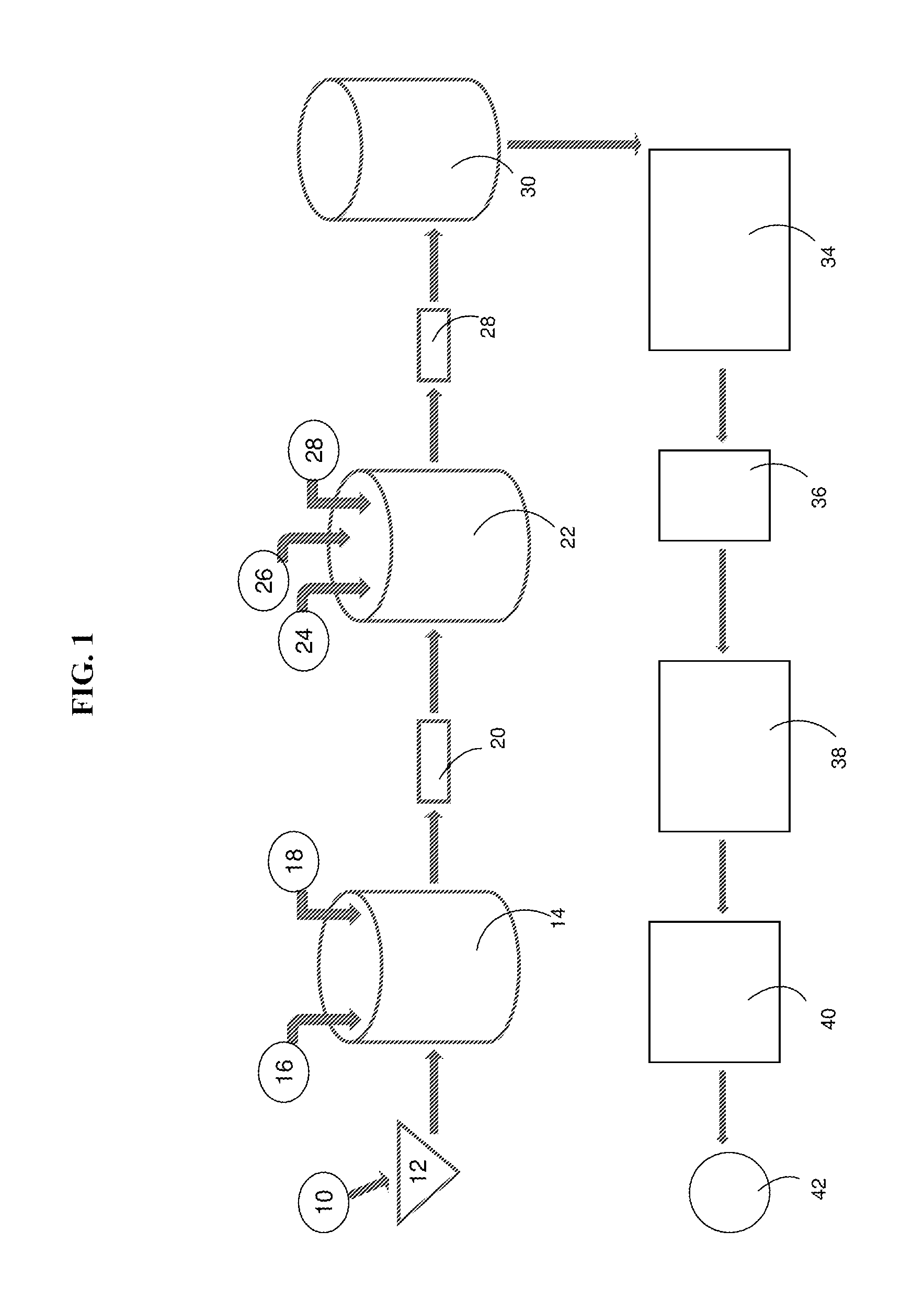Method for Preparing a Proteinaceous Vegetable Flavor Enhancer
a technology of proteinaceous vegetable and flavor enhancer, which is applied in the field of preparation of proteinaceous vegetable flavor enhancer, can solve the problems of high salt content in the final product, unsuitable use, and special limitations of the chemical hydrolysis process
- Summary
- Abstract
- Description
- Claims
- Application Information
AI Technical Summary
Benefits of technology
Problems solved by technology
Method used
Image
Examples
example 1
[0055]FIG. 1 is a flow diagram illustrating a representative method by which a proteinaceous vegetable flavor enhancer may be prepared in accordance with embodiments of the invention. Thus, referring to this FIGURE, a plant protein material like wheat gluten 10 is sheared in a high shear liquefier 12. The sheared material is then transferred to a batching tank 14. Both water 16 and an endoprotease 18 such as Alcalse are added to the batching tank which is maintained at about 70° C. (158° F.) for about three hours to kill any bacteria present and to solubilize the wheat gluten and increase yield in the final product. Heating up to about 90° C. (194° F.) may be used to reduce the heating time to as little as ½ hour.
[0056]The batch treated material is then optimally passed through a heat exchanger 20 to raise the temperature of the mixture to about 100° C. (212° F.) for about 10 minutes after which is cooled down to about 55° C. (131° F.) as it is transferred into a hydrolysis tank 22....
example 2
Effect of Yeast-to-Protein Ratio on the Process of Making Hydrolyzed Vegetable Protein
[0059]The effect of the yeast-to-protein ratio on the quality and yield of hydrolyzed vegetable protein (HVP) obtained from the fermentation of protein material was investigated by systematically varying the yeast-to-protein ratio in the starting reaction mixture, as well as using different materials (wheat gluten or soy protein) as the sources of protein. The results of these studies are summarized in Table 1 below, including the yield of MSG and HVP observed for each reaction, and a description of the flavor of the final product.
TABLE 1protein sourcewheatsoyMSGyieldBatchesyeastglutenprotein(%)(%)flavor descriptionA0254.9276MSG content is lowB0305.7259.6light umami,MSG is lowC0.10.4287.5969umami is good butweaker thanbatch ED0.10.99.4776very good umamiE0.1127.4467.8good umamiF022.51.2234G0251.6454.5H0.10.83.0566good sensorycharacter; hard to tellthe product is madefrom soy
[0060]As illustrated in T...
example 3
Pretreatment to Control Bacterial Contamination
[0063]A two-step procedure for pre-treating the proteinaceous vegetable material to achieve pasteurization was investigated by varying the temperature (temp1) and duration of heating (t1) of the first step, and the temperature (temp2) and duration of heating (t2) of the second step. The pre-treatments were run in the presence or absence of a preservative (sodium benzoate), and contamination of the final product was evaluated. The results are summarized in Table 2 below. The test method, which was directed to determining total aerobic bacteria at mesophillic temperatures (35 C.°) was carried out using an incubator set at 35 C.°±1 C.°, using Petrifilm AC plates. Samples were prepared using a general dilution procedure. The top film of the Petrifilm AC plate was lifted and 1 ml of sample was pipetted onto the center of the bottom film.
[0064]The top of the film was released down onto the inoculum. A spreader (recessed side down) was placed ...
PUM
| Property | Measurement | Unit |
|---|---|---|
| temperature | aaaaa | aaaaa |
| temperature | aaaaa | aaaaa |
| temperature | aaaaa | aaaaa |
Abstract
Description
Claims
Application Information
 Login to View More
Login to View More - R&D
- Intellectual Property
- Life Sciences
- Materials
- Tech Scout
- Unparalleled Data Quality
- Higher Quality Content
- 60% Fewer Hallucinations
Browse by: Latest US Patents, China's latest patents, Technical Efficacy Thesaurus, Application Domain, Technology Topic, Popular Technical Reports.
© 2025 PatSnap. All rights reserved.Legal|Privacy policy|Modern Slavery Act Transparency Statement|Sitemap|About US| Contact US: help@patsnap.com

